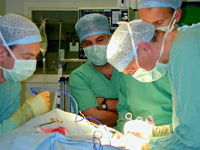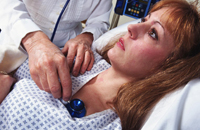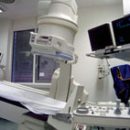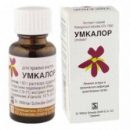What is osteomyelitis? How to diagnose the disease? What is the treatment of osteomyelita? You can find answers in this article.
Content
Osteomyelitis is an inflammatory disease of bones and bone marrow (Greek. Osteo - bone,
Mel - Brain, ending «IT» - means inflammation).
The disease is characteristic not only for the childhood period, it can affect adults.
Osteomyelitis may occur as a result of bone injury (fractures and t. NS.), i.e
The causative agent of the disease falls directly into the wound.
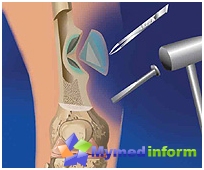
More often osteomyelitis is developing with hematogenous path of dissemination of infection. In this case, pathogenic microbes are already
are in the body and blood flow (t.E. Hematogenous) fall into the bone. The source of infection can be
carious teeth, chronic tonsillitis (t.E. chronic inflammation in the throat like
Corollary of frequent ANNIX) and other chronic foci of infection in the body.
The feature of the newborns is that they have already ready-made entrance
Gate for infection, such as an umbilical wound.
By the nature of the flow of osteomyelitis can be acute and chronic.
Newborn, this disease never acquires a chronic nature.
Spicy
Osteomyelitis in 70-80% of cases caused by gold staphylococcus (s. aureus).
In recent years, the defeat of newborns and children of early
age staphylococcal infection, it can be said that now the period
Staphylococcal boilers.
Infection
Newborn, as a rule, happens in maternity homes. Often fault
Medical staff and women in labor that are carriers
infection. The situation is also complicated by the fact that staphylococcus is very easy
adapts to antibacterial treatment and does not lose its aggressive
Properties. Air surrounding objects and linen in children's wards and maternity
halls can also serve as a source of infection. Master's mastitis can also
Cause of child infection.
Other
Osteomyelitis pathogens - Streptococci
Groups A, hemophilic stick, less often Salmonella, gram-negative
Enterobacteria, streptococci groups in. The most frequent localization of osteomyelitis
are tubular bones of limbs. Sometimes ribs are affected, vertebrae, bones
Skulls and especially often the upper jaw. In the newborn period, the disease is more
manifests itself during the first two weeks of life.
Ostomyelita symptoms
W
Older children pain in the affected bone - the very first and most bright
Symptom of the disease. In the first hours of painful character, then quickly
enhances, becomes drilling, driving. Pain enhanced at the slightest
movement, so the child gently affected. Since newborns
pain threshold increased, t.E. they are less sensitive to pain, and besides, they are not
can describe their feelings with words, painful symptom less bright. At
Cleaning the affected area is possible, anxiety. More often
pay attention to the fact that the child does not raise his hand or foot (limb «Cuts as
Plem»). The baby is sluggish, sleepy or the opposite is restless, refuses
chest.
Temperature, as a rule, rises to high
Numbers (39-40). Against high temperature, there may be cramps. maybe
redness of the skin and swelling of soft tissues above the lesion focus (due to
edema).
The amount of leukocytes increased in blood analysis
(leukocytosis), neutrophils (neutropyl) in the blood, ESO
erythrocytes) also raised.
How to diagnose osteomyelitis
Conduct blood crops and
other biological material. This allows you to find out which one
microorganism is the causative agent of the disease, also find out
Sensitivity to antibiotics.
Conduct computer
Tomography and radiography of affected bones. Typical radiographic
Signs of osteomyelitis appear only after 10-14 days from the beginning of the disease
In some cases, this period is lengthened.
In doubtful cases resort to diagnostic bone puncture.
The material obtained is examined on the composition of the cells, send to
Bacteriological research, to identify the pathogen and sensitivity to antibiotics.
How to treat osteomyelitis
Treatment should be carried out
exclusively in the hospital, under the constant supervision of medical personnel!
Timely started treatment allows in many cases to avoid complications.
As a rule, treatment
Start with the appointment of the shock dose of antibiotics.
From antibiotics more often
Use:
Antibiotics of the penicillin group (for example, oxacillin), the last generations of cephalosporins and others.
The duration of antibiotic therapy on average is 4-6 weeks.
In some cases, you have to resort to surgical treatment.
Osteopreopraration is produced, t.E. Opening of the affected area. In that
case after cut (naturally under anesthesia) remove purulent
Content and carry a bone-brain channel special
solutions.
In addition, the treatment complex includes immunotherapy (the introduction of anti-staphylococcal gammaglobulin, etc.), vitaminotherapy.
Under the subsistress of acute inflammatory process, physiotherapeutic treatment, special physical education.



